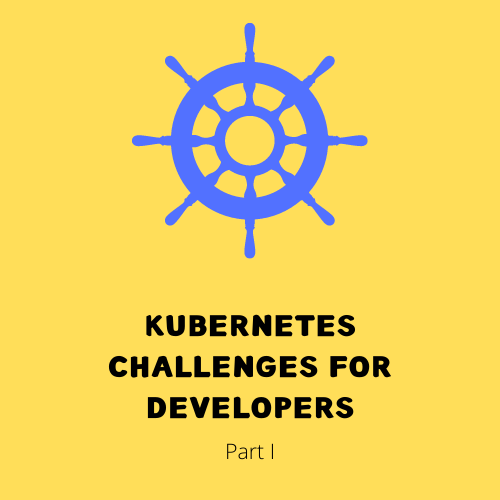Kubernetes Challenges for Developers - Part I
in Kubernetes

Cloud-native applications have seen increasing adoption of Kubernetes when it comes to container clustering. Kubernetes has offered immense ease and convenience to the end-users and enabled them to develop technologically advanced services more rapidly.
However, as it continues to grow and be adopted more widely by the developer community, the framework is also experiencing new challenges and limitations.
Numerous management challenges can make developers wary of using the framework. If you are looking to ease out the way Kubernetes can be operated, here are the challenges that you must address and resolve.
1. When you work with YAML manually
The creation of numerous YAML manifest files is a big part of working with Kubernetes.
Now, YAML is already a complex framework to work with, and since Kubernetes requires manual creation of these files, the work becomes even more cumbersome. Plus, Kubernetes uses an advanced level of YAML, which further complicates matters. This invites an abundance of redundant steps that need to be managed individually, something that no developer appreciates or likes.
Even if someone can work with the redundant steps, they are left with a huge number of tiny YAML files to deal with. When one sits down to reverse-map all of this, the task can be quite herculean. In several cases, these YAML files also grow at an alarming rate. The manual management of all of these files is simply an impossible task to carry out. In this scenario, automation via solutions such as Cloudplex is a must. Automating the creation of YAML manifest files in Kubernetes will enable developers to generate thousands of YAML files without putting in much manual labor into the work. Doing so saves up a lot of time and enables developers to focus on other core competencies.
2. When managing your application lifecycle
The idea of container-based applications like Kubernetes is to enable frequent bug releases and software updates easily. Whether you need to release one every day, every week, or every month, the task can be carried out via Kubernetes efficiently. However, this ease of software update releases also poses one of the biggest limitations for Kubernetes. When any code repository receives too many code commits from numerous sources, it is bound to trigger unforeseen and unusual user responses. This eventually leads to the codebase breaking down.
For uninterrupted deployment, developers need continuous integration tools such as Jenkins.
These tools allow developers to seamlessly release application updates without worrying about the codebase breaking down or the framework triggering any unusual bugs for the end-user.
However, integrating these continuous integration tools with Docker isn’t exactly a cakewalk either. The process can be time-consuming, require a lot of manual configuration, and is also prone to human errors.
3. When working with K8s volumes
Working with persistent data in Kubernetes requires developers to configure elements using the concept of volumes.
This operation further requires the configuration of persistent volumes, persistent volume claims, storage classes, and more. This also needs to be configured for all Docker containers individually. This volume management in Kubernetes also becomes a big challenge for developers to address. The first challenge regarding this is that the storage class of each cloud vendor plays a big role in determining the binding of persistent volume with claims.
Now, every cloud vendor comes with its own storage structure, and to be able to map the binding successfully, the developer needs to learn this structure. Doing so is incredibly effort-intensive and time-consuming. Plus, Docker containers in Kubernetes need to be configured manually, and managing this is a challenge in itself. Even the slightest of errors in configuring the persistent volumes, persistent volume claims, or storage classes will not allow the volume to attach to the container leading to a nonfunctional Kubernetes framework.
4. When working in different environments and with different configurations
The configuration of containers in the Kubernetes framework plays a crucial role in determining how it will perform in production. This key-value pair configuration depends on the environment variables or dynamic parameters. Often, we believe that the configuration of dynamic parameters isn’t a cumbersome task and can be carried out pretty easily. However, that’s not true. Inside a Kubernetes framework, the configuration of dynamic parameters is one of the biggest limitations a developer can face.
In most applications, numerous containers interact with each other based on the key-value configuration. Reassigning value to dynamic parameters in such an environment can be immensely tricky and complicated. The slightest of errors will send all the containers in limbo and will result in a non-functional application. Since existing container implementations need to be taken care of when reassigning values to a new container, the entire process can become quite lengthy and complicated.
5. When you want to bootstrap a cluster
Several components come together to form an extensive and robust Kubernetes infrastructure.
Some of the most crucial ones include security, load balancing, DNS, and role-based access control or RBAC. Now, when a developer sits down to deploy a complete and integrated Kubernetes cluster, the process isn’t exactly easy. The setup takes a long time and requires a deeper understanding of Kubernetes functionality as well as the cloud provider’s functionality.
One solution to this can be provider-managed Kubernetes clusters. They are fairly easy to work with and do not require intense understanding. They can also be configured very quickly as opposed to working on them from scratch. However, these provider-managed Kubernetes clusters do not allow developers to use their own custom machine images.
This limits the capability and customization of the Kubernetes clusters tremendously and doesn’t allow the developer any freedom of usage.
Conclusion
Kubernetes provides immense value to the developers, but it comes with its own challenges and limitations. Since Kubernetes is a complex and advanced structure, resolving these limitations isn’t always straightforward and quick.
A lot goes into maintaining a robust and fully-functional Kubernetes framework, and addressing these limitations can be a starting point when striving to achieve this perfection. However, these aren’t the only challenges one needs to address.
In “Kubernetes Challenges Part II”, we talk about five more challenges that one can come across when working with a Kubernetes framework. These include Kubernetes RBAC, Network and Traffic Management, Kubernetes Autoscaling, Associating Pods to Nodes, and Integration with Legacy Services.
Get similar stories in your inbox weekly, for free
Share this story:

Cloudplex
Founder and CEO of Cloudplex - We make Kubernetes easy for developers.
Latest stories
How ManageEngine Applications Manager Can Help Overcome Challenges In Kubernetes Monitoring
We tested ManageEngine Applications Manager to monitor different Kubernetes clusters. This post shares our review …
AIOps with Site24x7: Maximizing Efficiency at an Affordable Cost
In this post we'll dive deep into integrating AIOps in your business suing Site24x7 to …
A Review of Zoho ManageEngine
Zoho Corp., formerly known as AdventNet Inc., has established itself as a major player in …
Should I learn Java in 2023? A Practical Guide
Java is one of the most widely used programming languages in the world. It has …
The fastest way to ramp up on DevOps
You probably have been thinking of moving to DevOps or learning DevOps as a beginner. …
Why You Need a Blockchain Node Provider
In this article, we briefly cover the concept of blockchain nodes provider and explain why …
Top 5 Virtual desktop Provides in 2022
Here are the top 5 virtual desktop providers who offer a range of benefits such …
Why Your Business Should Connect Directly To Your Cloud
Today, companies make the most use of cloud technology regardless of their size and sector. …
7 Must-Watch DevSecOps Videos
Security is a crucial part of application development and DevSecOps makes it easy and continuous.The …








